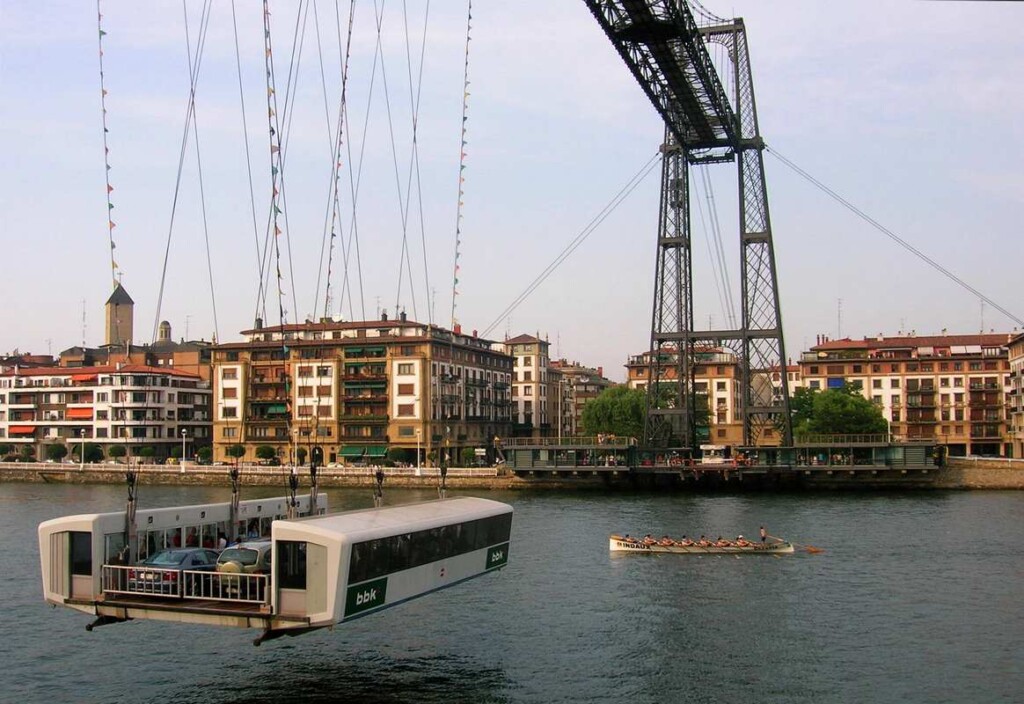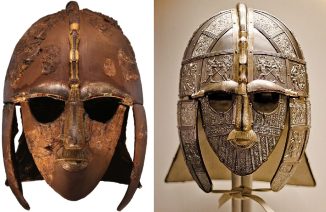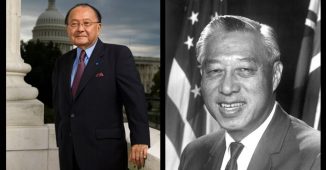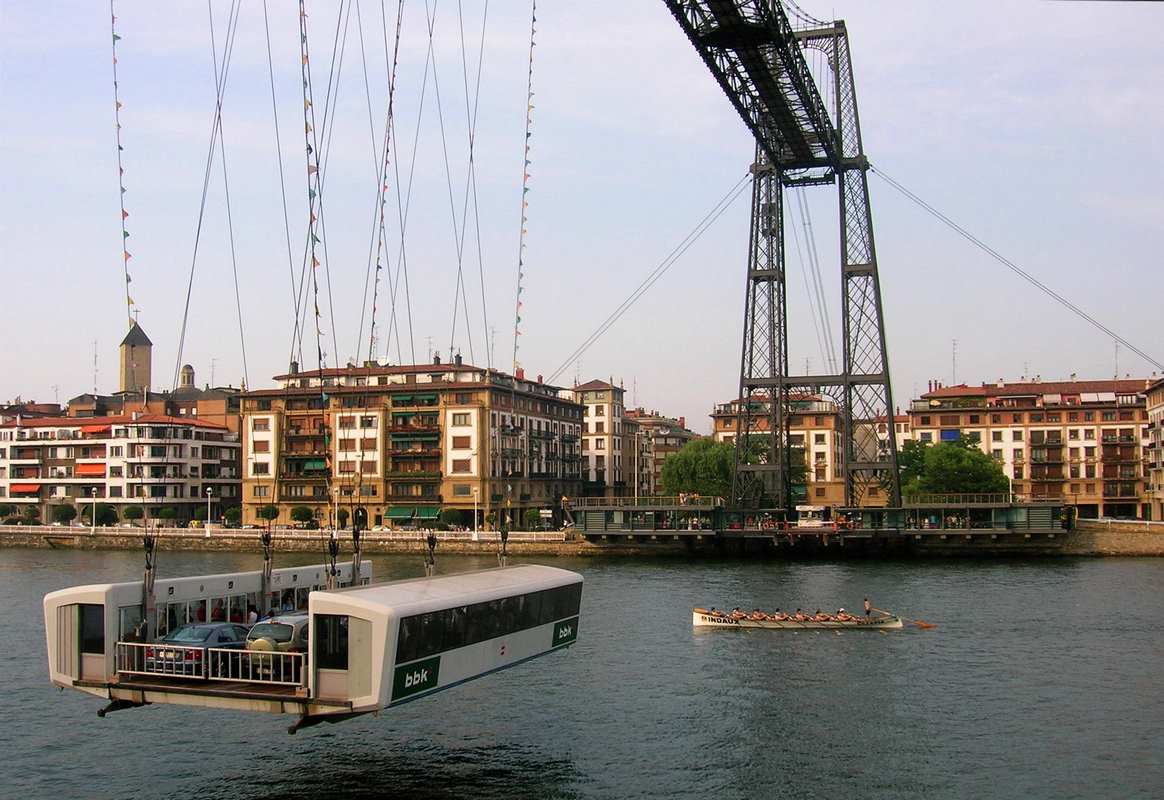130 years ago today, the Vizcaya Bridge, Spain’s only UNESCO World Heritage Site of industrial heritage was completed. Spanning the two banks situated at the mouth of the Nervion River, connecting the towns of Portugalete and Las Arenas, it is the world’s oldest transporter bridge, using a 6-car gondola suspended on steel cables to ferry people and vehicles across the water without disrupting maritime traffic. READ about the one-of-a-kind bridge… (1893)

There’s no walking across Vizcaya. It works like a horizontal elevator and has only been disrupted once in its whole history during the Spanish Civil War. Designed by Alberto Palacio, one of Gustave Eiffel’s disciples, UNESCO considers the bridge to be a perfect combination of beauty and functionality.
It was the first to use a combination of iron technology and new steel cables which began a new form of constructing bridges which was later imitated throughout the world.
The structure is made of four 61-meter towers which are the pillars and stand on the river banks. The towers are braced by iron cables to the crossbeam and are parallel to the river and by cables following the line of the bridge into the hill behind (on the Portugalete side) and the ground (on the Las Arenas side).
The upper crossbeam which lies horizontally, rests between two towers by 70 suspension cables. They also help support a great amount of weight and are supported in the corbels which helps balance the weight. The gondola transports vehicles and they hang from a 36-wheeled caty. It moves along the rails through the horizontal crossbeam.
MORE Good News on this Day:
- The Fourteenth Amendment to the U.S. Constitution, guaranteeing due process and equal protection under the law to former slaves, was declared in effect—and the first part, “No State shall deprive any person of life, liberty, or property, without due process of law; nor deny to any person the equal protection of the laws”—formed the basis for landmark legal decisions such as Brown v. Board of Education, Roe v. Wade, and Obergefell v. Hodges (1868)
- The city of Miami, Florida was incorporated (1896)
- Australian Ian Thorpe became the first swimmer to win 6 gold medals at a single World Championships (2001)
- Nine coal miners were rescued after 77 hours trapped underground in the flooded Quecreek Mine in Pennsylvania (2002)
- The Provisional Irish Republican Army (IRA) officially ended its 30-year armed campaign to win the independence of Northern Ireland and began the full decommissioning of its weapons under international supervision, saying they would pursue exclusively peaceful means to its ends (2005)
84 years ago today, small iron and bronze fragments found during the Sutton Hoo ship burial were determined to be part of a kingly helmet. Buried around 625 and is widely associated with King Rædwald of East Anglia, its elaborate decoration may have given it a secondary function akin to a crown. The helmet was also a functional piece of armor that would have offered considerable protection if ever used in warfare. The Sutton Hoo Helmet has been called one of the most spectacular archeological discoveries ever made, and a symbol of the discipline writ large.

The helmet was made of iron, with the decorations on the upper part made with bronze, and those on the cheek flaps and visage made in silver, gold, and other alloys including bronze. The skull protection was covered in motifs of men fighting, while the crest and eyebrows were individual dragons. Leather hinges allowed the iron flaps to fit the wearer’s jawline and fully enclose his face.
One of the best things in archeology is when the evidence it produces supports, or even confirms, legends of the past, and while the helmet in its glory of gold, silver, and garnet gems would have seen most use as a decorative piece, there’s strong evidence that Rædwald, or indeed whoever owned it, not only rode to battle wearing it, but actually engaged in battle wearing it. Damage to the back of the helmet, some scholars have pointed out, carries more similarities to a blow from a weapon rather than the decay of time. (1940)
202 years ago today, Peru declared its independence from Spain and became a republic. The bicentennial celebration commemorates two centuries since José de San Martín, the ‘Protector of Peru’ proclaimed the South American nation free from Spanish rule. It was San Martin who created the first Peruvian flag.

In the early 19th century, Peru remained a royalist stronghold, with its elite class vacillating between emancipation and loyalty to the Spanish Monarchy. Independence was achieved only after the occupation by military campaigns of San Martín and Simón Bolívar.
Home to the Inca civilization and Machu Picchu, Peru is a megadiverse country—from its arid plains, to the peaks of the Andes mountains in the west, and tropical Amazon Basin rainforests in the east. Peru, with its capital of Lima, has a population 33 million and is the 19th largest country in the world, by area—the third largest in South America.
Today, a rural school teacher and union leader is set to be sworn in as Peru’s new president. Running under the slogan, “No more poor people in a rich country,” the leftist Pedro Castillo has promised to redistribute mineral wealth that flows from Peru’s position as the world’s second-largest copper producer. (1821)
And 94 years ago today, Jacqueline Bouvier Kennedy Onassis was born in Southampton, New York.

As First Lady and wife to President Kennedy, she brought babies to the White House for the first time in a half-century. She spent a year restoring the White House with historical furnishings that were missing when she arrived and established a culture of elegance in the building, which has lasted to this day. (1929-1994)

And, on this day in 1866, Beatrix Potter, the beloved children’s author and illustrator was born. From her first beautifully illustrated book, The Tale of Peter Rabbit in 1902, she went on to create a series of stories based around animal characters including Mrs. Tiggy-Winkle and Jemima Puddle-Duck. Not just a humorous storyteller and artist who, as a botanist, could render scientific illustrations, she was also an environmentalist, sheep farmer and businesswoman. With determination, she overcame professional rejection, academic humiliation, and personal heartbreak, to go on to earn a fortune.

And, on this day in 1959, in their preparation for newly-declared U.S. statehood, Hawaiians voted to elect the first Asian-American—Hiram L. Fong (R)—to the U.S. Senate, and the first Japanese-American—Daniel K. Inouye (D)—to the House of Representatives. Inouye (pictured, left), a World War II veteran who lost his right arm to a grenade blast, also served as a Senator from Hawaii until his death in 2012, having never lost an election in 58 years. He rose to become President pro tempore—making him the highest-ranking Asian-American politician in US history.
And, Happy 78th Birthday to Jim Davis, whose Garfield cartoon is one of the world’s most widely syndicated comic strips.

Since 1978, the sarcastic feline has been grinning from pages—and was eventually joined by other Davis newspaper notables such as Tumbleweeds, Gnorm Gnat, and Mr. Potato Head. Garfield was inspired by Davis’s childhood memories growing up on a small farm in Indiana with 25 cats. (1945)
SHARE the Milestones, Memories, and Music…




















